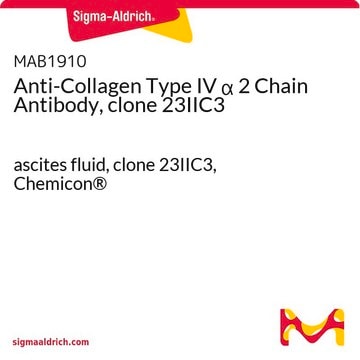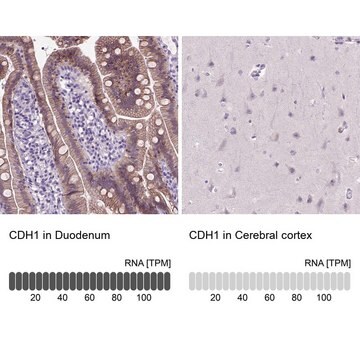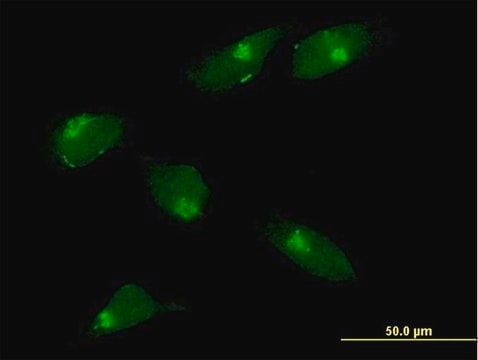MAB4037
Anti-PTEN Antibody, CT, clone A2b1
clone A2b1, Chemicon®, from mouse
Sinonimo/i:
MMAC1, TEP1
About This Item
Prodotti consigliati
Origine biologica
mouse
Livello qualitativo
Forma dell’anticorpo
purified immunoglobulin
Tipo di anticorpo
primary antibodies
Clone
A2b1, monoclonal
Reattività contro le specie
human, rat, mouse
Produttore/marchio commerciale
Chemicon®
tecniche
immunocytochemistry: suitable
immunohistochemistry: suitable
immunoprecipitation (IP): suitable
western blot: suitable
Isotipo
IgG1
Compatibilità
not suitable for immunohistochemistry (Paraffin)
N° accesso NCBI
N° accesso UniProt
Condizioni di spedizione
wet ice
modifica post-traduzionali bersaglio
unmodified
Informazioni sul gene
human ... PTEN(5728) , TEP1(7011)
Specificità
*PTEN is covered under U.S. patents 6,262,242, 6,482,795 and U.S. patent application 10/299,003.
Immunogeno
Applicazioni
Signaling
PI3K, Akt, & mTOR Signaling
Immunocytochemistry
Immunohistochemistry: 1:20 to 1:50 for acetone-fixed, fresh frozen tissue. Not effective for paraffin sections.
Immunoprecipitation 1:10 to 1:20
Protocol for immunohistochemistry of frozen tissue sections on glass slides.
1. Fix sections for 5 minutes with cold acetone.
2. Air dry
3. Wash sections with PBS
4. Add blocking solution (horse serum) for 20 minutes
5. Add diluted PTEN antibody and incubate for 1 hour at room temperature.
6. Wash with PBS
7. Add biotinylated secondary antibody (horse anti-mouse, or equivalent).
8. Incubate for 30 minutes at room temperature.
9. Wash with PBS
10. Detect with ABC (Avidin-Peroxidase-Complex) or equivalent.
11. Wash with PBS
12. Develop with DAB substrate.
13. Hematoxylin dye may be used as a counterstain for visualizing nuclei.Breast tumor tissue gives good staining. Prostate tissue does not stain.Optimal working dilutions must be determined by end user.
Descrizione del bersaglio
Linkage
Stato fisico
Stoccaggio e stabilità
Risultati analitici
Breast tumor tissue
Purified active kinase is Catalogue Number 14-488
Altre note
Note legali
Esclusione di responsabilità
Non trovi il prodotto giusto?
Prova il nostro Motore di ricerca dei prodotti.
Raccomandato
Codice della classe di stoccaggio
10 - Combustible liquids
Classe di pericolosità dell'acqua (WGK)
WGK 2
Punto d’infiammabilità (°F)
Not applicable
Punto d’infiammabilità (°C)
Not applicable
Certificati d'analisi (COA)
Cerca il Certificati d'analisi (COA) digitando il numero di lotto/batch corrispondente. I numeri di lotto o di batch sono stampati sull'etichetta dei prodotti dopo la parola ‘Lotto’ o ‘Batch’.
Possiedi già questo prodotto?
I documenti relativi ai prodotti acquistati recentemente sono disponibili nell’Archivio dei documenti.
Il team dei nostri ricercatori vanta grande esperienza in tutte le aree della ricerca quali Life Science, scienza dei materiali, sintesi chimica, cromatografia, discipline analitiche, ecc..
Contatta l'Assistenza Tecnica.








